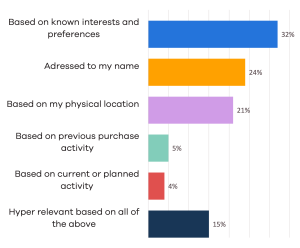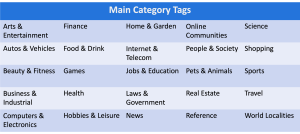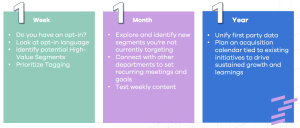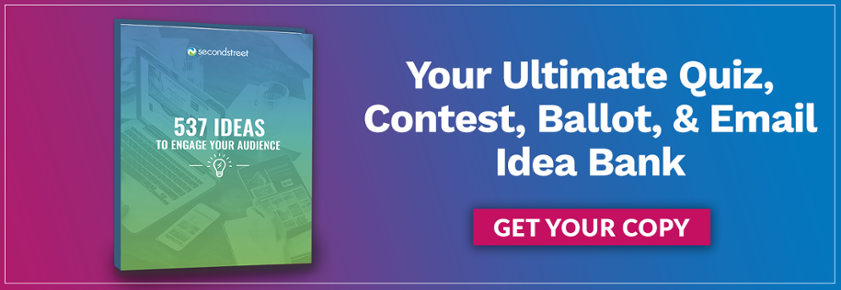We know you are in the beginning stages of creating, growing, and monetizing your First Party Data strategy. Learn why building a First Party Data strategy doesn’t have to be a daunting task and is easily achievable with Second Street. This step-by-step process will help you drive a more engaged audience, conversions, and subscriber revenue by targeting and growing your audiences.
A First Party Data Review
As a level-set, let’s make sure we know what First Party Data really is and how you might already be using it today. First Party Data is data that directly supplied to you by your audience. This could be their email, name, demographic information, their interests, etc. You can collect this information through registration forms and promotions! And in order to act on this data, you need to also collect consent and permission through explicit opt-ins.
First Party Data is already part of your overall goals like audience growth, increased revenue, advertiser leads, and higher open rates. You also are most likely using First Party Data to an extent through things like niche newsletters and promotions that tie into programming or content creation.

The Importance and Benefits of First Party Data
One of the biggest reasons organizations are now focusing on a First Party Data strategy is because third party cookies are going away. You will no longer by able to lean on data that you’ve received from other sources through third party cookies – which for some organizations is one of the largest ways they receive data about their users.
This is where a First Party Data strategy comes into play. If you start to collect First Party Data, you are getting that data straight from the source – meaning you are collecting clean, reliable data.
Collecting this data yourself will also help to lower marketing costs and increase ROI. This is because you are no longer paying a third party for this data! You will also be able cover cost and bring in revenue by including sponsors or advertisers. And, if these promotions lead to more content sources and programming capabilities, that’s even more cost-savings and increased ROI!
Another benefit of a First Party Data strategy is the increased ability to segment your audiences. Elevated segmentation and personalization helps to improve:
- Relevancy: Tailoring communication with individual data points will improve engagement
- Cadence: Allows you to send more frequently to people who are consistently responding to your messages, and save disengaged audiences for high value, general interest content
- Customer Journeys: Match your communications to a customer’s relationship stage
- ROI: Segmented campaigns account for more than half (58%) of all email ROI and behavioral/interest-based segmentation brings highest ROI. Demographic only segmentation isn’t going to cut it – people expect more
What Level of Personalization Users Expect

Build Your Plan
Before you launch your First Party Strategy, you need to start with a plan. This will help set you your full strategy up for success!
Evaluate What You Have
This first step may seem simple – but it’s where you need start! Dive through all of your data to see what is ALREADY there. A great way to get a handle on this is to start with interest tagging. Second Street provides you with a very easy way to tag all of your promotions – use it!
Along with focusing on your high engagement promotions, look at the last 6 months of promotions you’ve run and tag them.
Determine Your Internal Initiatives
You need to make sure that your strategy aligns with your current goals. Look at what you need to achieve and how a First Party Data strategy can help you achieve those goals! Do you need to grow certain advertising categories? Focus more on personalizing content? Increase advertising revenue? These types of goals can help you create more FOCUS within your strategy.
Create A Strategy
Now that you’ve addressed what you already have and pinpointed your initiatives, your ready to begin creating your strategy! When developing your strategy, start asking yourself:
- How are you including your internal initiatives within this strategy?
- Who do you need buy in from?
- How can you explain your case internally?
- What achievable goals can you set to test that your strategy is working?
Launch Your First Party Data Strategy
Now that you’ve created a plan, you’re ready to focus on the creation and launch of your strategy!
Get Proper Consent
First and foremost, you NEED to make sure you have an opt-in for users to provide explicit consent on everything. Make sure your opt-ins are not pre-checked so that your users are providing action and explicitly opting in. You can also scrub your lists of unengaged users so you are only targeting those who are actively engaging with you.
Focus on Tagging
You’ve already tagged your previous 6 months of promotions, and you need to continue tagging moving forward! The Second Street platform has tagging functionality out of the box, so use that functionality and focus on main category tags. Don’t get too niche with your tagging – you most likely aren’t ready for that yet!

Use Segmented Audiences
When creating your segmented audiences, make sure the first filter you add is an opt-in to ensure everyone in that audience has provided explicit consent. From there, add filters like postal code and interest tags to filter to your ideal audience. This is where the importance of segmentation comes in! Use your segmented audiences to deliver relevant content, increase communication cadence, enhance your customer journeys, and increase your ROI.
Evaluate and Act
Now that you’ve developed your strategy with the steps above, what segments can you now act on immediately? Can you target certain advertiser categories NOW because you know you have a solid customer base to promote within?
You can also focus on growing where you are lacking. Are there certain categories where you have little to no data on? These are categories you can attack to drive database growth.
And finally, continue to test an innovate! None of us will get this 100% right the first time. The point is to start with a strategy, take action, and then review and innovate on what you learned from that action.
Looking Forward
The best way to move forward is to start planning your strategy NOW! If you don’t, you’ll begin to fall behind. Make your strategy a year-long initiative – and focus on small chunks of time. What can you get done in 1 week, 1 month, 1 year? Divide up what you need to tackle and make sure to get executive-level buy-in so that your whole organization is aligned with the same goals in mind!

Related Articles

Lead-Gen Sweepstakes Helps New Business Stake It’s Claim
by Julie Foley Second Street

Liz Huff Second Street
Liz is the Senior Director of Customer Success and has an extensive background in media. She is a huge advocate of the power of promotions for every department within an organization, including sales, marketing, audience development, and editorial.



